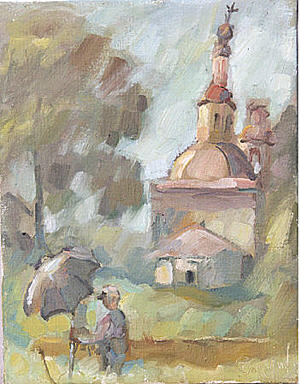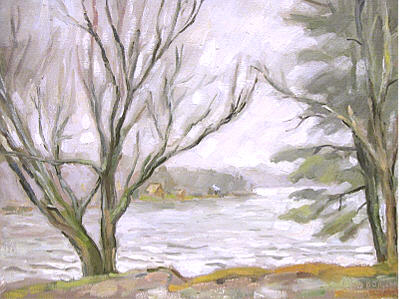|
Home > News > Archives > Stas Borodin > Color Harmony
A World of Color Harmony:
The Paintings of Stas Borodin

The paintings of Stas Borodin are a world of color harmony, the integrity of a plein-air perception of the atmosphere, a mise en valeur vision (the subtleties of light and color relationships, transmitting the feeling of air and space). With the soft tone transitions, everything is based on nuances — both the color scheme and the mood.
The transient is seen as eternal. Perhaps that is the best way to sum up first impressions of his paintings in just a few words. Delicately discrete, dim but very light, they possess a magical attraction. They create a contemplative mood. It is almost impossible to enter the artist's world in a rush. But if you have time enough, you will see the beauty and grandeur of nature, the quiet life of objects, the spirituality and inner concentration of his models.
There are only three themes in Borodin's work: portrait, still life, and landscape. All the others are deliberately excluded, because they also require solving problems unrelated to painting, because the artist' s primary interests are the plasticity of forms, and fine painting. Borodin' s work is not a typical phenomenon on today's art scene. At a time when everyone fell for avant-garde, the artist did not give in to the "automatism of innovation," but turned to the achievements of the pictorial culture and found his own ways of developing them, he does not want to surprise anyone with "novelty," nor to create "something."

A worshipper of nature, he must express his perception of the world. Therefore he needs to find his own "well chosen artistic means." .The St. Petersburg artist has always felt close to the great traditions of the French plein-air school of the 19th and 20th centuries, nearly forgotten in today's painting. They helped his talent grow stronger and enter into the big art life. Inventively combining the discoveries of the plastic possibilities of color (both in figurative and in abstract painting), the artist solves the manifold tasks of plein-air painting.
It must be noted that Stas Borodin only paints from nature, which is a great rarity nowadays. In his work method, in the system of special color construction of the painting, he goes from abstraction to the object, from open color to the finest nuances of near similar tones. He paints not an object on canvas, but a space filled with light and air. The light in his works fills the whole polyphony of undertones with the force of life. The luminosity of color is manifold and expressive; Borodin attempts to unite the seemingly incompatible: Cezanne's ideas and methods of form-building with Corot's system of mise en valeur. That is, he constructs the rigid plasticity of nature transfixed in time and endows it with the airy transience of an impression. Going further than the metaphysical version of the art world, he supplements it with a subtle poetic message of an emotional state. He creates a synthesis of being and becoming. In his paintings, reality appears peculiarly primeval, removed from the ordinary. There are no people in it, no details of the present day, it is an ideal image characterized by eternal categories, but it is experienced in a very intimate way.
 Note the painter in the foreground, with the parasol and easel. Borodin painted this painting and both of the preceeding ones during the seminar in July. |
Stas likes traveling and travels often. He sees it is as a form of an active artistic life. For him, the opening of the Russian borders meant above all the possibility of exploring world art collections and getting acquainted with the contemporary art world. He talks of his plein-air work with much poetry: ''as I travel, I paint in the studio under the open sky, sometimes dipping my brushes in the rays of sunshine, dewdrops, rain currents, the ringing frosty air". He is rarely attracted by "gala views." He finds his own motifs, discovering a picturesque angle in the most unprepossessing corner. His representation of landscape is usually concrete and precise, but his understanding of local color is not ethnographical, rather he sees it literally as the originality of light and color. Therefore, whatever Stas may paint — be it panoramas of the Neva, the Seine, the Rein, or the Moselle; the urban landscapes of Germany or Holland;, the harbors of Barcelona or Stockholm; the desert of Israel; or a Belgian orchard — his landscapes are dominated by the life of nature, by the plastic equivalent of its atmosphere.
For him, this task is above all linked with the development and fulfillment of the utmost possibilities of perception. It requires a particular training of the eye, capable of seeing the smallest variations in the life of color. Recording thousands of color impressions, he creates a system of light-and-color relationships and brings them to a harmonious unity.
 "Kingsbury Pond", November 2003 |
Stas Borodin has chosen a difficult road — the one leading to pictorial perfection. This is the way he understands his artistic growth. As a painter, he developed under the supervision of the well-known Moscow artist Vladimir Vaisberg. A nine-year-long association with the great master became a serious school of professionalism for the young artist. Now, at the age of 50, he is in the prime of his creative power. Those who have followed the development of the artist closely would know how much he has achieved. He has walked a thorny path from modest studies to works of high artistic merit and great pictorial culture. After 17 years of rejection of his work method on the part of the official art, he had his first personal exhibition in 1989. By now he has had 50 exhibitions, of which 27 were held abroad. His works are known in Germany, Sweden, Belgium, Slovakia. Spain, France, and the U.S.A. His paintings have been bought by museums and corporative and private collectors.
by Tatyana Borodina, art critic
Member of Russian Artists Union
Member of Critics Association (AIS), 2003.
<— Back • Top
|





